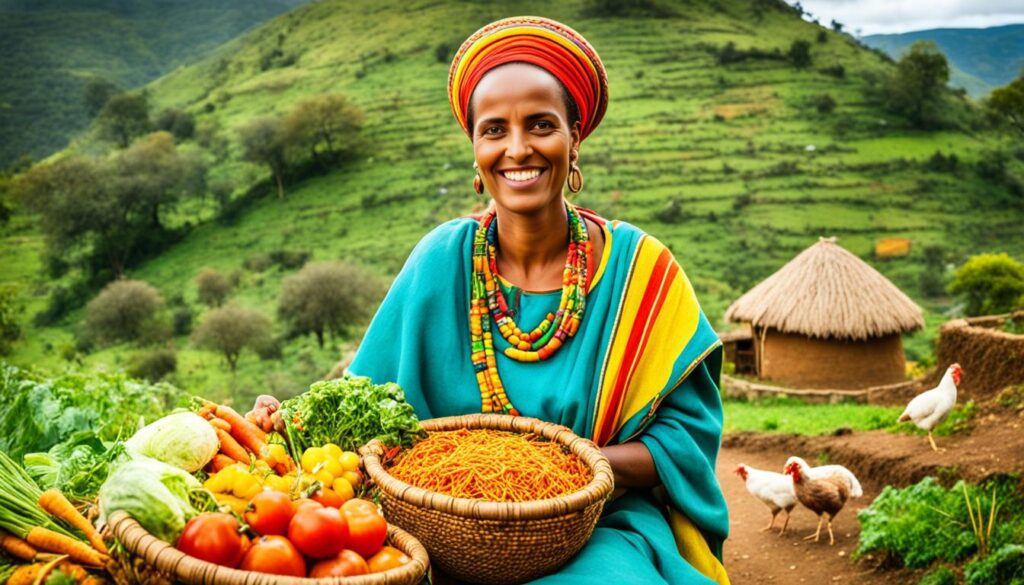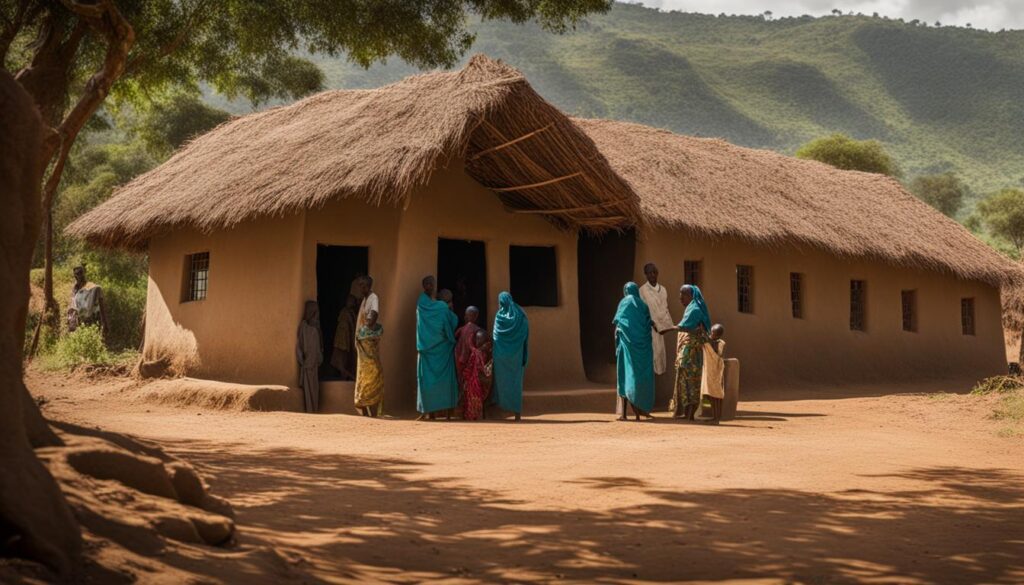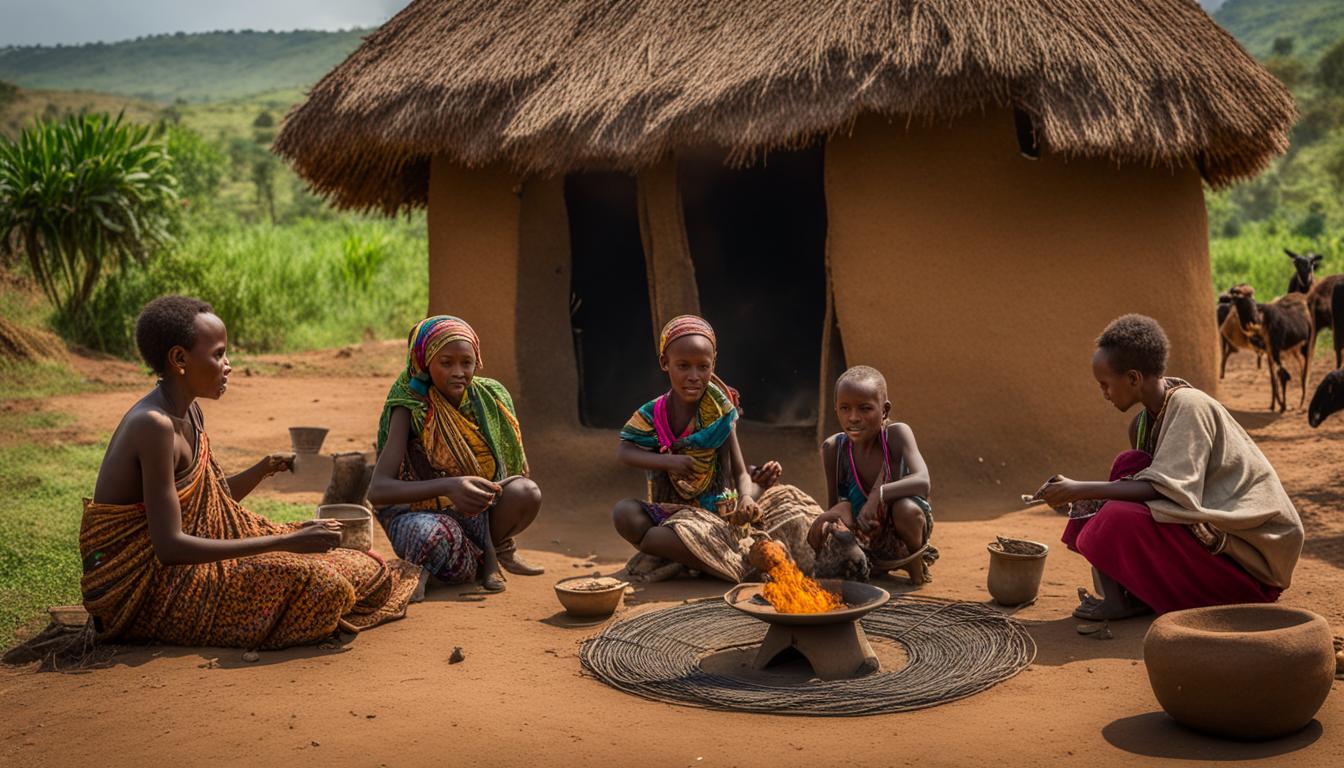How Do People Live in Ethiopia?
Did you know that Ethiopia, located in the Horn of Africa, is home to the second largest population in Africa? With a population of over 114 million people, this culturally rich and diverse country has a fascinating daily life that is worth exploring. Despite being one of the fastest growing economies in the region, Ethiopia remains one of the poorest nations in the world. In this article, we will delve into the lifestyle of Ethiopians, shedding light on their traditional customs, food habits, housing, and community life.
Key Takeaways:
- Despite economic challenges, Ethiopia has a rich cultural heritage and a vibrant daily life.
- Traditional customs and festivals play a significant role in Ethiopian culture.
- Access to clean water, sanitation, healthcare, and education are areas of improvement in Ethiopia.
- Rural and urban areas in Ethiopia present contrasting living conditions and opportunities.
- The Ethiopian government is implementing strategies to improve living conditions and create more opportunities.
Living Conditions in Ethiopia
Ethiopia faces significant challenges in terms of living conditions. Access to clean water and sanitation is limited, with over 61 million people lacking clean water and 65 million without proper sanitation. The housing crisis has led to 80 percent of the population in Addis Ababa living in slums, and the health system is underdeveloped, leading to a prevalence of preventable diseases. Additionally, unemployment rates, especially among the youth, contribute to the difficulties faced by Ethiopians.
Despite these challenges, the Ethiopian people display resilience and determination to improve their living conditions. Efforts are being made by the government and various organizations to address these issues and provide a better quality of life for all Ethiopians.
Let’s take a closer look at some key aspects of living conditions in Ethiopia:
Access to Clean Water and Sanitation
With over 61 million people lacking access to clean water and 65 million without proper sanitation facilities, the lack of basic necessities is a significant challenge in Ethiopia. This limited access to clean water leads to a multitude of health problems and perpetuates the cycle of poverty.
Housing Crisis in Addis Ababa
Addis Ababa, the capital city of Ethiopia, is grappling with a severe housing crisis. Approximately 80 percent of the population in Addis Ababa lives in slums, with inadequate living conditions and limited access to essential services. This rapid urbanization has put immense pressure on the existing infrastructure and led to a shortage of proper housing options for the growing population.
Healthcare Challenges
The healthcare system in Ethiopia is underdeveloped, contributing to a high prevalence of preventable diseases. Limited access to quality healthcare services and medical facilities further exacerbates the health challenges faced by Ethiopians. Efforts are being made to improve healthcare infrastructure and ensure better access to healthcare services, especially in rural areas.
Unemployment Rates
Unemployment rates, particularly among the youth, pose significant challenges to the Ethiopian population. Limited job opportunities and a lack of skills development programs contribute to high unemployment rates, making it difficult for individuals to meet their basic needs and improve their living conditions.
Despite these challenges, the Ethiopian people are resilient and resourceful in finding ways to improve their living conditions. Efforts are being made by the government, NGOs, and various organizations to address these issues and create a sustainable and prosperous future for all Ethiopians.
| Challenges | Statistics |
|---|---|
| Access to clean water | Over 61 million people lacking clean water |
| Sanitation facilities | 65 million people without proper sanitation |
| Addis Ababa housing crisis | 80 percent of the population living in slums |
| Healthcare challenges | High prevalence of preventable diseases |
| Unemployment | High unemployment rates, especially among the youth |
Traditional Customs and Culture in Ethiopia

Ethiopian culture is a treasure trove of traditions and customs that have been passed down through generations, providing a glimpse into the rich history of this remarkable country. Ethiopians take immense pride in their cultural heritage, which is deeply intertwined with their daily lives.
Festivals and Ceremonies
One of the most fascinating aspects of Ethiopian culture is the celebration of various festivals and ceremonies throughout the year. These events are vibrant and colorful, bringing communities together and providing a sense of belonging. The most famous festival is the Timkat, a religious celebration marking the baptism of Jesus Christ in the Jordan River. It involves processions, prayers, and the reenactment of the baptism, creating a joyous and spiritual atmosphere.
Ethiopian Cuisine
The culinary traditions of Ethiopia are renowned worldwide for their unique flavors and ingredients. Injera, a sourdough flatbread, is a staple in Ethiopian cuisine and serves as the foundation for many dishes. It is typically served with wat, a spicy stew made with various vegetables, lentils, or meat. The combination of injera and wat creates a delightful feast for the taste buds. Coffee, another integral part of Ethiopian culture, is deeply rooted in daily life and often served in elaborate coffee ceremonies.
Traditional Attire, Music, and Dance
The traditional attire of Ethiopians is captivating, reflecting the diversity of the culture across different regions of the country. The vibrant colors and intricate designs of the clothing showcase the creativity and craftsmanship of Ethiopian artisans. Music plays a central role in Ethiopian culture, with unique musical styles and instruments like the krar and masenqo. Traditional Ethiopian dances are characterized by rhythmic movements, graceful gestures, and energetic performances that captivate audiences.
Exploring the cultural heritage of Ethiopia is a journey of discovery filled with traditions, flavors, and customs that have stood the test of time. It provides a deeper understanding of the values and way of life of the Ethiopian people, reinforcing the significance of preserving and celebrating their rich cultural heritage.
Rural vs Urban Life in Ethiopia
When it comes to life in Ethiopia, there exists a contrast between rural and urban areas. With the majority of the population residing in rural regions, rural life in Ethiopia is characterized by scattered homesteads nestled near fertile farm plots, creating close-knit communities.
Traditional Ethiopian rural dwellings are typically circular or rectangular, constructed using locally available materials such as mud, wood, or thatch. These sustainable structures showcase the resourcefulness and creativity of the rural population in making the best use of what their environment offers.
On the other hand, urban centers like Addis Ababa, the capital city, provide a different experience for inhabitants. Boasting a bustling atmosphere, the city attracts migrants from the rural areas in search of better opportunities and improved access to services.
Urban life in Ethiopia offers a range of amenities and facilities, including modern infrastructure, educational institutions, healthcare facilities, and diverse employment opportunities. It is within these urban centers that one can witness the blend of modernity and tradition, as Ethiopia progresses on its path of development.
However, despite the allure of urbanization, rural communities continue to play a significant role in Ethiopia’s economy and way of life. Agriculture, predominantly carried out in rural areas, remains a vital sector, contributing to the country’s food security and livelihoods.
Whether in the rural or urban landscape, the heart of Ethiopia beats with resilience and a vibrant spirit, adding to the diverse fabric of the nation. Let us explore further into Ethiopian education and access to healthcare in the next section.
Education and Access to Healthcare in Ethiopia

Access to education has improved over the years in Ethiopia, with efforts to build more schools in rural areas and increase enrollment rates. However, challenges remain, particularly in remote areas.
The Ethiopian education system is working towards providing quality education for all its citizens. However, there are still disparities in access to education, with children in rural areas facing more significant barriers. Despite the efforts made, many children in remote communities struggle to attend school due to factors such as long distances, poverty, cultural norms, and limited resources.
| Challenges in the Ethiopian Education System | Efforts for Improvement |
|---|---|
|
|
The healthcare system in Ethiopia also faces significant challenges. Ethiopia has made progress in improving healthcare infrastructure and services, but access to quality healthcare remains limited, especially in rural areas.
Healthcare in Ethiopia is hindered by a shortage of medical professionals, inadequate facilities, and a lack of funding. The prevalence of preventable diseases such as malaria, HIV/AIDS, and respiratory infections further strain the healthcare system.
Efforts to Improve Healthcare in Ethiopia
Despite these challenges, efforts are being made to improve healthcare in Ethiopia. The government has implemented various initiatives to expand healthcare services, particularly in rural areas. These initiatives include:
- Building and upgrading healthcare facilities.
- Training and deploying more healthcare workers.
- Improving access to essential medicines and vaccines.
- Strengthening disease prevention and control programs.
The image above represents the resilience and determination of healthcare professionals in Ethiopia, working tirelessly to provide essential care to their communities.
Economic Opportunities and Employment in Ethiopia
Despite being one of the fastest-growing economies in Africa, Ethiopia continues to grapple with high unemployment rates, particularly among the youth. We recognize the need for concerted efforts to address this challenge and create sustainable job opportunities. While the government has taken proactive steps to reduce unemployment, the private sector’s active participation is crucial for driving long-term economic growth in the country.
One promising avenue for employment growth lies in the field of information technology (IT). As technology continues to advance, the demand for skilled IT professionals is on the rise. This sector presents an untapped potential for job creation, as it aligns with Ethiopia’s focus on diversifying its economy and embracing digital transformation. By investing in IT infrastructure and fostering innovation, Ethiopia can harness the power of technology to drive economic growth and create employment opportunities.
In addition to IT, various other sectors hold promise for expanding employment opportunities and strengthening the Ethiopian economy. These include manufacturing, agriculture, tourism, and renewable energy. By tapping into Ethiopia’s vast agricultural resources and promoting value-added agricultural products, the country can enhance its international competitiveness and create jobs across the agricultural value chain.
“Harnessing the potential of Ethiopia’s economic sectors and creating employment opportunities is crucial for sustainable development and poverty reduction in the country.”
To illustrate the potential impact of these efforts, let’s take a closer look at the current employment landscape in Ethiopia.
Employment Statistics in Ethiopia
| Year | Unemployment Rate |
|---|---|
| 2016 | 5.7% |
| 2017 | 5.9% |
| 2018 | 6.1% |
| 2019 | 6.3% |
| 2020 | 6.5% |
While the unemployment rate in Ethiopia has shown a slight increase over the years, it is important to note that these figures do not fully capture the extent of underemployment and informal employment in the country. Many individuals work in the informal sector, which often lacks social protection and stable income. Addressing these challenges requires comprehensive and inclusive strategies that focus on improving the overall quality of employment opportunities.
Through targeted policies and partnerships between the government, private sector, and international organizations, Ethiopia can foster an enabling environment for job creation and economic growth. By investing in education and vocational training, promoting entrepreneurship, and facilitating access to finance for small and medium-sized enterprises (SMEs), we can boost employment prospects and empower individuals to contribute actively to the country’s development.
Together, we can work towards a brighter future for Ethiopia, where economic opportunities abound, and employment is a reality for all.
Migration and Refugee Crisis in Ethiopia

Ethiopia has become a refuge for many displaced individuals, with a significant number of refugees seeking safety from neighboring countries such as Somalia, Eritrea, Sudan, and South Sudan. This influx of ethiopian refugees has created a complex humanitarian situation, impacting both Ethiopia and the countries of origin.
Internal migration is also a common phenomenon in Ethiopia, as many Ethiopians choose to leave their homes in search of better opportunities elsewhere. This internal movement is driven by various factors, including conflicts, government land-resettlement schemes, and natural disasters.
These migration patterns have profound social and economic implications for both Ethiopia and the countries where Ethiopians seek refuge. While hosting a large number of refugees poses challenges, it also demonstrates Ethiopia’s commitment to providing sanctuary to those in need. The internal migration of Ethiopians reflects the pursuit of better livelihoods and the desire for improved economic prospects.
The Impact of Migration
Migration is both a response to and a driver of social and economic change. It affects the lives of individuals, families, and communities, shaping societies on various levels.
The refugee crisis in Ethiopia has strained resources and put pressure on the country’s infrastructure, healthcare, and education systems. Despite these challenges, Ethiopia continues to welcome and support refugees, providing them with essential services and opportunities for self-reliance.
Internal migration, on the other hand, impacts both rural and urban areas. It contributes to demographic shifts, labor market dynamics, cultural exchange, and the development of new communities. However, it also presents challenges as rural areas experience a loss of skilled workers and an increase in population density in urban centers.
The Need for Collaboration
Addressing the migration and refugee crisis requires collaboration and cooperation at the national, regional, and international levels. It is essential for countries of origin, host countries, and international organizations to work together to mitigate the challenges faced by refugees and ensure their well-being.
Efforts are also needed to address the root causes of migration, including conflicts and poor economic conditions. By promoting stability, economic development, and human rights, countries can create an environment that encourages individuals to remain in their homes and communities.
Furthermore, integrating refugees into the host country’s society and economy can have mutually beneficial outcomes. By providing access to education, healthcare, and employment opportunities, host countries can enable refugees to rebuild their lives and contribute to the overall development of the country.
Overall, the migration and refugee crisis in Ethiopia highlights the need for concerted efforts to protect the rights and well-being of ethiopian refugees and address the underlying causes of migration. By fostering collaboration and implementing comprehensive solutions, we can create a more inclusive and sustainable future for everyone.
Note: The image above depicts a group of Ethiopian refugees seeking shelter and safety.
Efforts for Improvement in Ethiopia
Ethiopia’s commitment to progress and development is evident through its implementation of the Growth and Transformation Plan. This ambitious plan aims to achieve significant economic growth and address the country’s most pressing challenges by 2025. Through targeted efforts in crucial sectors such as health, education, and finance, Ethiopia is striving to improve the lives of its people and create a brighter future for all.
The Growth and Transformation Plan focuses on improving living conditions and reducing poverty, recognizing that sustainable development requires addressing the fundamental needs of the population. Efforts are being made to enhance access to quality healthcare services, expand educational opportunities, and promote financial inclusion.
Healthcare for All
One of the key areas of focus in Ethiopia’s development plan is healthcare. The government has implemented measures to improve the quality and accessibility of healthcare services across the country. Efforts are being made to strengthen healthcare infrastructure and increase the availability of trained medical professionals, especially in rural areas. Additionally, initiatives are in place to tackle prevalent diseases and improve preventive care measures.
“Our goal is to ensure that every Ethiopian has access to quality healthcare services. We are working tirelessly to improve the healthcare system and provide comprehensive care to all citizens.” – Minister of Health, Ethiopia
Educational Opportunities for All
Education is a vital aspect of Ethiopia’s growth and transformation plan. The government has taken significant steps to increase access to education and improve the quality of learning for all Ethiopians. Efforts include building new schools, training teachers, and providing resources to underserved areas. These initiatives aim to reduce disparities in educational opportunities and empower the younger generation with the necessary skills for a brighter future.
“Education is the key to unlocking the immense potential of our nation. We are committed to ensuring that every child in Ethiopia has access to quality education and the opportunity to build a prosperous future.” – Minister of Education, Ethiopia
Financial Inclusion and Economic Empowerment
Ethiopia’s growth and transformation plan also emphasizes the importance of financial inclusion and economic empowerment. Efforts are underway to promote access to financial services, particularly for underserved populations. This includes initiatives to expand microfinance programs, promote entrepreneurship, and support small and medium-sized enterprises. By fostering economic opportunities, Ethiopia aims to alleviate poverty and create a more inclusive and prosperous society.
“We believe that everyone should have the opportunity to participate in and benefit from the growth of our economy. Through targeted programs and policies, we are working to empower individuals and communities, driving sustainable economic development.” – Minister of Finance, Ethiopia
Through the implementation of the Growth and Transformation Plan, Ethiopia is making significant strides towards improvement and development. By addressing key sectors and focusing on the needs of its people, Ethiopia is committed to building a more prosperous and equitable nation.
Conclusion
Living conditions in Ethiopia are a complex mix of challenges and opportunities. Despite facing poverty and limited access to basic amenities, Ethiopians possess a strong cultural heritage and a resilient spirit. Efforts are underway to improve living conditions and create a better future for all Ethiopians.
By understanding and appreciating the vibrant daily life of Ethiopians, we can gain insights into their unique culture and contribute to sustainable development in the country. It is important to recognize the progress being made and support initiatives that address poverty, healthcare, education, and employment challenges.
As Ethiopia strives to achieve its growth and transformation goals, it is crucial for individuals, communities, and organizations to come together and actively participate in the country’s development. Together, we can make a difference and help create a brighter future for all Ethiopians.





